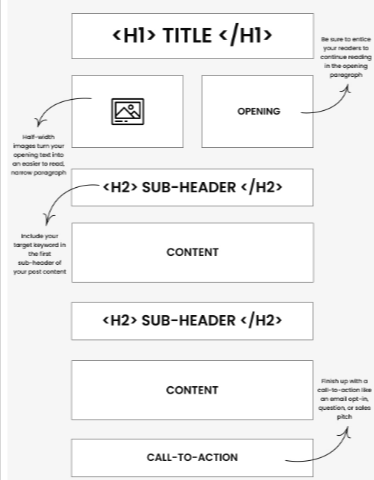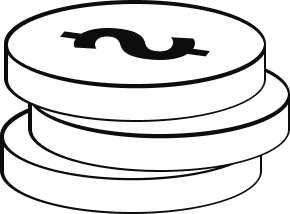So, your blog post is live. You picked some good keywords, added a cool image, and hit publish.
But a week later…. Where’s the traffic? Why isn’t your post ranking on Google?
Let’s talk about something super important that many people miss when writing blog posts:
Traffic is the result. But structure is the driver.
Most people think writing a blog is all about words. But great writing is just the beginning. If your blog is not structured the right way, readers will leave fast, and Google will notice.
Let’s break down what truly matters when you are putting together a blog post:
Your Title Tag: The First Hello to Google
Imagine your title as the name tag you wear when you meet someone new. It’s the very first thing Google sees, and it’s what pops up when people search for something. It needs to be clear, concise, and inviting.
- Keep it under descriptive. Think of it like a short, punchy headline.
- Put your main topic keyword right at the beginning. This immediately tells Google and readers what your article is about.
- Make it sound interesting and click-worthy. Ask yourself, “Would I click on this?”
- Make sure it matches what people are searching for. If they are looking for “best running shoes,” your title shouldn’t be “footwear for athletes.”
The URL Slug: Your Blog Post’s Address
This is the web address for your specific blog post. Just like a good street address, it should be easy to understand and remember.
- Keep it short and to the point.
- Include your main keyword here, too. It is another signal to search engines.
- Try to avoid little words like “a,” “the,” “and,” etc. These are called stop words and can make your URL longer and less clear.
The Main Blog Heading (H1): Your Article’s Big Welcome
This is the big, bold title you see at the very top of your blog post. It is your official welcome to the reader.
- Naturally include your main keyword. Don’t force it in, but make sure it’s there.
- It should be similar to your title tag, so readers don’t feel misled.
- Most importantly, it should be catchy and easy for people to read and understand.
The Introduction: The Hook that Keeps Them Reading
The intro is your opportunity to hook the reader and let them know why they need to continue reading. If your intro falls flat, no one will stick around to find out about your fantastic content.
- Begin with strength! Pose a question that makes people think, provide an interesting fact, or take a strong stance.
- Give them a clear idea of what they will be reading. Provide them with a map.
- Attempt to include your focus keyword in your first sentence or two. This will immediately inform readers and search engines about what your post is about.
The Featured Image: A Visual Storyteller
This is your featured image, which typically sits at the top of your blog post. It’s more than merely a nice photo.
- Ensure it is of good quality and specifically pertains to your blog subject.
- Add “alt text” to the image. It is a brief description of the image that has your keywords. It helps individuals who can’t see the image (such as screen reader users) and assists search engines in knowing what the image is about.
- A good image breaks up the text and makes your blog more attractive to readers.
Subheadings (H2 / H3): Your Content’s Navigation System
Think about reading an entire book with no chapters or paragraphs. That’s what reading a blog post with no subheadings is like. They divide your content into manageable, bite-sized pieces that are easy to read.
- Use H2 headings for your main areas, similar to the way chapters work in a book.
- Use H3 (and H4 if you need even further information) for sub-parts within those main sections.
- These headings make your material much simpler to scan and perceive, particularly for readers who are only skimming.
- Of course, incorporate your keywords into these headings where appropriate.
Internal Links: Connecting Your Content Dots
Internal links are like pathways within your website. They connect your blog post to other relevant pages on your site.
- Try to link to at least one or two other relevant pages on your website. This helps readers explore more of your content.
- Use clear and descriptive words for your links (this is called anchor text). Instead of “click here,” say “learn more about content marketing.”
- Internal links help spread the authority of your website, showing search engines how your content is connected.
External Links: Building Trust and Credibility
External links are when you link out to other, trustworthy websites. Think of it like citing your sources in a research paper.
- Link to one or two reliable, high-quality external sources. This adds credibility to your content.
- It shows readers (and search engines) that you have done your research and are providing accurate information.
- Again, use descriptive and relevant words for your links.
Supporting Visuals: More Than Just Decoration
These are the other images, graphs, charts, or illustrations you include throughout your blog post. They are incredibly helpful for explaining complex ideas.
- Use visuals that add clarity to your points. A graph can explain data much faster than words.
- Ensure that all your images have descriptive labels and keyword-focused alt text, the same way your header image does.
Call to Action (CTA): What Do You Want Them to Do Next?
- This is where you instruct your readers to do something after reading your blog post. It is the conversion point of your mini-marketing funnel.
- Encourage your reader to do something specific. Do you want them to comment, download a guide, sign up for a newsletter, or give something a try?
- Ensure your CTA is clearly visible and relevant to the material in your blog post.
Conclusion: Wrapping It All Up
This is where you direct your readers to do something next—it’s the conversion point of your mini-marketing funnel. If you want them to comment, download a guide, subscribe to a newsletter, or test a product, your call to action (CTA) needs to be simple and directly related to what they just read. Make it easy to find and easy to act upon.
So, let’s wrap it up. The conclusion is your opportunity to briefly reiterate the key points of your blog and make a lasting impression. Recap the key takeaways and, if you can, add a final CTA that flows naturally. You may even wish to pose a considerate question to garner comments and responses.
Want real results? Then the answer is simple: fix your structure first. It’s not just the foundation—it’s the blueprint for success.


